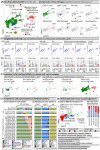This is a preprint.
Multiomic single-cell sequencing defines tissue-specific responses in Stevens-Johnson Syndrome and Toxic epidermal necrolysis
- PMID: 38405793
- PMCID: PMC10888802
- DOI: 10.1101/2023.11.26.568771
Multiomic single-cell sequencing defines tissue-specific responses in Stevens-Johnson Syndrome and Toxic epidermal necrolysis
Update in
-
Multiomic single-cell sequencing defines tissue-specific responses in Stevens-Johnson syndrome and toxic epidermal necrolysis.Nat Commun. 2024 Oct 8;15(1):8722. doi: 10.1038/s41467-024-52990-3. Nat Commun. 2024. PMID: 39379371 Free PMC article.
Abstract
Stevens-Johnson syndrome and toxic epidermal necrolysis (SJS/TEN) is a rare but life-threatening cutaneous drug reaction mediated by human leukocyte antigen (HLA) class I-restricted CD8+ T-cells. To obtain an unbiased assessment of SJS/TEN cellular immunopathogenesis, we performed single-cell (sc) transcriptome, surface proteome, and TCR sequencing on unaffected skin, affected skin, and blister fluid from 17 SJS/TEN patients. From 119,784 total cells, we identified 16 scRNA-defined subsets, confirmed by subset-defining surface protein expression. Keratinocytes upregulated HLA and IFN-response genes in the affected skin. Cytotoxic CD8+ T-cell subpopulations of expanded and unexpanded TCRαβ clonotypes were shared in affected skin and blister fluid but absent or unexpanded in SJS/TEN unaffected skin. SJS/TEN blister fluid is a rich reservoir of oligoclonal CD8+ T-cells with an effector phenotype driving SJS/TEN pathogenesis. This multiomic database will act as the basis to define antigen-reactivity, HLA restriction, and signatures of drug-antigen-reactive T-cell clonotypes at a tissue level.
Figures


Similar articles
-
Multiomic single-cell sequencing defines tissue-specific responses in Stevens-Johnson syndrome and toxic epidermal necrolysis.Nat Commun. 2024 Oct 8;15(1):8722. doi: 10.1038/s41467-024-52990-3. Nat Commun. 2024. PMID: 39379371 Free PMC article.
-
Current Perspectives on Stevens-Johnson Syndrome and Toxic Epidermal Necrolysis.Clin Rev Allergy Immunol. 2018 Feb;54(1):147-176. doi: 10.1007/s12016-017-8654-z. Clin Rev Allergy Immunol. 2018. PMID: 29188475 Review.
-
CD94/NKG2C is a killer effector molecule in patients with Stevens-Johnson syndrome and toxic epidermal necrolysis.J Allergy Clin Immunol. 2010 Mar;125(3):703-10, 710.e1-710.e8. doi: 10.1016/j.jaci.2009.10.030. Epub 2010 Feb 4. J Allergy Clin Immunol. 2010. PMID: 20132973
-
Stevens-Johnson Syndrome and Toxic Epidermal Necrolysis in the Era of Systems Medicine.Methods Mol Biol. 2022;2486:37-54. doi: 10.1007/978-1-0716-2265-0_3. Methods Mol Biol. 2022. PMID: 35437717
-
Stevens-Johnson syndrome and toxic epidermal necrolysis: risk factors, causality assessment and potential prevention strategies.Expert Rev Clin Immunol. 2020 Apr;16(4):373-387. doi: 10.1080/1744666X.2020.1740591. Epub 2020 Apr 2. Expert Rev Clin Immunol. 2020. PMID: 32154748 Review.
References
-
- Chung W.H., et al. Medical genetics: a marker for Stevens-Johnson syndrome. Nature 428, 486 (2004). - PubMed
-
- Chung W.-H., et al. Granulysin is a key mediator for disseminated keratinocyte death in Stevens-Johnson syndrome and toxic epidermal necrolysis. Nature Medicine 14, 1343–1350 (2008). - PubMed
Publication types
Grants and funding
LinkOut - more resources
Full Text Sources
Research Materials
